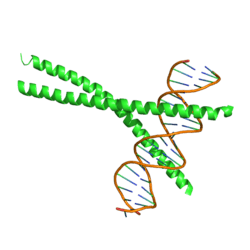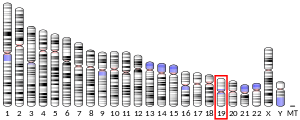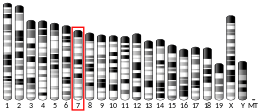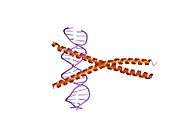CEBPA
CCAAT/enhancer-binding protein alpha is a protein encoded by the CEBPA gene in humans.[5][6] CCAAT/enhancer-binding protein alpha is a transcription factor involved in the differentiation of certain blood cells.[7] For details on the CCAAT structural motif in gene enhancers and on CCAAT/Enhancer Binding Proteins see the specific page.
Function
The protein encoded by this intronless gene is a bZIP transcription factor which can bind as a homodimer to certain promoters and gene enhancers. It can also form heterodimers with the related proteins CEBP-beta and CEBP-gamma, as well as distinct transcription factors such as c-Jun. The encoded protein is a key regulator of adipogenesis (the process of forming new fat cells) and the accumulation of lipids in those cells, as well as in the metabolism of glucose and lipids in the liver.[8] The protein has been shown to bind to the promoter and modulate the expression of the gene encoding leptin, a protein that plays an important role in body weight homeostasis. Also, the encoded protein can interact with CDK2 and CDK4, thereby inhibiting these kinases and causing cultured cells to stop dividing.[9] In addition, CEBPA is essential for myeloid lineage commitment and therefore required both for normal mature granulocyte formation and for the development of abnormal acute myeloid leukemia.[10]
Common mutations
There are two major categories which CEBPA mutations can be categorized into. One category of mutations prevent CCAAT/enhancer-binding protein alpha DNA binding by altering its COOH-terminal basic leucine zipper domain. The other category of mutations disrupt the translation of the CCAAT/enhancer-binding protein alpha NH2 terminus. CEBPA mutations, which result in diminished CCAAT/enhancer-binding protein alpha activity, contribute to the transformation of myeloid antecedents.[11]
Interactions
CEBPA has been shown to interact with Cyclin-dependent kinase 2[12] and Cyclin-dependent kinase 4.[12]
Clinical significance
It has been shown that mutation of CEBPA has been linked to good outcome in both adult and pediatric acute myeloid leukemia patients.[13]
Significance in acute myeloid leukemia
Acute myeloid leukemia is characterized by genetic abnormalities in hematopoietic progenitors. This includes excessive proliferation of blasts, and blocking the hematopoiesis of granulocytes. It has been shown that suppression of CEBPA expression and blocking of CCAAT/enhancer-binding protein alpha stops the differentiation of myeloid progenitors. For this reason, CCAAT/enhancer-binding protein alpha's role during granulocyte differentiation and CEBPA's role as a tumor suppressor gene is critically important in the prognosis of acute myeloid leukemia.[14]
Prognostic significance of CEBPA mutations
CCAAT/enhancer-binding protein alpha, the transcription factor that is encoded by CEBPA, is very important in the differentiation of immature granulocytes. Mutation of the CEBPA gene has been shown to play a crucial role in leukemogenesis and prognosis in acute myeloid leukemia patients. In recent studies CEBPA mutations were found in between 7% and 15% of patients with acute myeloid leukemia. The three different types of mutations seen in these AML patients include germ-line N-terminal mutation, N-terminal frameshift mutation, and C-terminal mutation. These mutations are most frequently found in acute myeloid leukemia M1 or acute myeloid leukemia M2. Many reports link CEBPA mutations with a favorable outcome in acute myeloid leukemia. This is because these mutations are likely to induce differentiation arrest in these patients. Patients with CEBPA mutations have longer remission duration and survival time than those without the mutations.[11] Therefore, the presence of CEBPA mutations are directly associated with a more favorable course for the progression of the disease.[15]
Significance in solid tumors
Recently it has been shown that epigenetic modification of the distal promoter region of CEBPA has resulted in downregulation of CEBPA expression in pancreatic cancer cells, lung cancer, and head and neck squamous cell carcinoma.[16][17]
Methylation of CEBPA as a prognostic biomarker in AML patients
A recent study has found that higher levels of CEBPA methylation are directly proportionate with treatment response. The complete response rate increased proportionately with the level of CEBPA methylation. For this reason it has been proposed that methylation of CEBPA could be a very useful biomarker in acute myeloid leukemia prognosis.[18]
See also
- Ccaat-enhancer-binding proteins
References
- GRCh38: Ensembl release 89: ENSG00000245848 - Ensembl, May 2017
- GRCm38: Ensembl release 89: ENSMUSG00000034957 - Ensembl, May 2017
- "Human PubMed Reference:". National Center for Biotechnology Information, U.S. National Library of Medicine.
- "Mouse PubMed Reference:". National Center for Biotechnology Information, U.S. National Library of Medicine.
- Szpirer C, Riviere M, Cortese R, Nakamura T, Islam MQ, Levan G, Szpirer J (July 1992). "Chromosomal localization in man and rat of the genes encoding the liver-enriched transcription factors C/EBP, DBP, and HNF1/LFB-1 (CEBP, DBP, and transcription factor 1, TCF1, respectively) and of the hepatocyte growth factor/scatter factor gene (HGF)". Genomics. 13 (2): 293–300. doi:10.1016/0888-7543(92)90245-N. PMID 1535333.
- Cao Z, Umek RM, McKnight SL (October 1991). "Regulated expression of three C/EBP isoforms during adipose conversion of 3T3-L1 cells". Genes Dev. 5 (9): 1538–52. doi:10.1101/gad.5.9.1538. PMID 1840554.
- "CEBPA". Genetics Home Reference. April 20, 2016. Retrieved April 25, 2016.
- Olofsson LE, Orho-Melander M, William-Olsson L, Sjöholm K, Sjöström L, Groop L, Carlsson B, Carlsson LM, Olsson B (1 December 2009). "CCAAT/enhancer binding protein alpha (C/EBPalpha) in adipose tissue regulates genes in lipid and glucose metabolism and a genetic variation in C/EBPalpha is associated with serum levels of triglycerides". The Journal of Clinical Endocrinology & Metabolism. 93 (12): 4880–4886. doi:10.1210/jc.2008-0574. PMID 18765514.
- "Entrez Gene: CEBPA CCAAT/enhancer binding protein (C/EBP), alpha".
- Ohlsson E, Schuster MB, Hasemann M, Porse BT (Apr 2016). "The multifaceted functions of C/EBPalpha in normal and malignant haematopoiesis". Leukemia. 30 (4): 767–75. doi:10.1038/leu.2015.324. PMID 26601784.
- Lin LI, Chen CY, Lin DT, Tsay W, Tang JL, Yeh YC, et al. (2005). ""Characterization of CEBPA mutations in acute myeloid leukemia " most patients with CEBPA mutations have biallelic mutations and show a distinct immunophenotype of the leukemic cells". Clin Cancer Res. 11: 1372–9. doi:10.1158/1078-0432.ccr-04-1816.
- Wang H, Iakova P, Wilde M, Welm A, Goode T, Roesler WJ, Timchenko NA (October 2001). "C/EBPalpha arrests cell proliferation through direct inhibition of Cdk2 and Cdk4". Mol. Cell. 8 (4): 817–28. doi:10.1016/S1097-2765(01)00366-5. PMID 11684017.
- Ho PA, Alonzo TA, Gerbing RB, Pollard J, Stirewalt DL, Hurwitz C, Heerema NA, Hirsch B, Raimondi SC, Lange B, Franklin JL, Radich JP, Meshinchi S (June 2009). "Prevalence and prognostic implications of CEBPA mutations in pediatric acute myeloid leukemia (AML): a report from the Children's Oncology Group". Blood. 113 (26): 6558–66. doi:10.1182/blood-2008-10-184747. PMC 2943755. PMID 19304957.
- Lin TC, Hou HA, Chou WC, Ou DL, Yu SL, Tien HF, et al. (2011). "CEBPA methylation as a prognostic biomarker in patients with de novo acute myeloid leukemia". Leukemia. 25: 32–40. doi:10.1038/leu.2010.222.
- El-Sharnouby JA, Ahmed LM, Taha AM, Kamal O. Prognostic significance of CEBPA mutations and BAALC expression in acute myeloid leukemia Egyptian patients with normal karyotype. Egypt J Immunol. 2010;15:131–143.
- Tada Y, Brena RM, Hackanson B, Morrison C, Otterson GA, Plass C (2006). "Epigenetic modulation of tumor suppressor CCAAT/enhancer binding protein alpha activity in lung cancer". J Natl Cancer Inst. 98: 396–406. doi:10.1093/jnci/djj093.
- Bennett KL, Hackanson B, Smith LT, Morrison CD, Lang JC, Schuller DE, et al. (2007). "Tumor suppressor activity of CCAAT/enhancer binding protein alpha is epigenetically down-regulated in head and neck squamous cell carcinoma". Cancer Res. 67: 4657–4664. doi:10.1158/0008-5472.can-06-4793.
- Lin TC, Hou HA, Chou WC, Ou DL, Yu SL, Tien HF, et al. (2011). "CEBPA methylation as a prognostic biomarker in patients with de novo acute myeloid leukemia". Leukemia. 25: 32–40. doi:10.1038/leu.2010.222.
Further reading
- Sladek FM, Darnell JE (1992). "Mechanisms of liver-specific gene expression". Curr. Opin. Genet. Dev. 2 (2): 256–9. doi:10.1016/S0959-437X(05)80282-5. PMID 1638120.
- Marcucci G, Mrózek K, Bloomfield CD (2005). "Molecular heterogeneity and prognostic biomarkers in adults with acute myeloid leukemia and normal cytogenetics". Curr. Opin. Hematol. 12 (1): 68–75. doi:10.1097/01.moh.0000149608.29685.d1. PMID 15604894.
- Leroy H, Roumier C, Huyghe P, Biggio V, Fenaux P, Preudhomme C (March 2005). "CEBPA point mutations in hematological malignancies". Leukemia. 19 (3): 329–34. doi:10.1038/sj.leu.2403614. PMID 15674366.
External links
- Human CEBPA genome location and CEBPA gene details page in the UCSC Genome Browser.
- GeneReviews/NIH/NCBI/UW entry on Familial Acute Myeloid Leukemia (AML) with Mutated CEBPA
- CEBPA+protein,+human at the US National Library of Medicine Medical Subject Headings (MeSH)
This article incorporates text from the United States National Library of Medicine, which is in the public domain.





